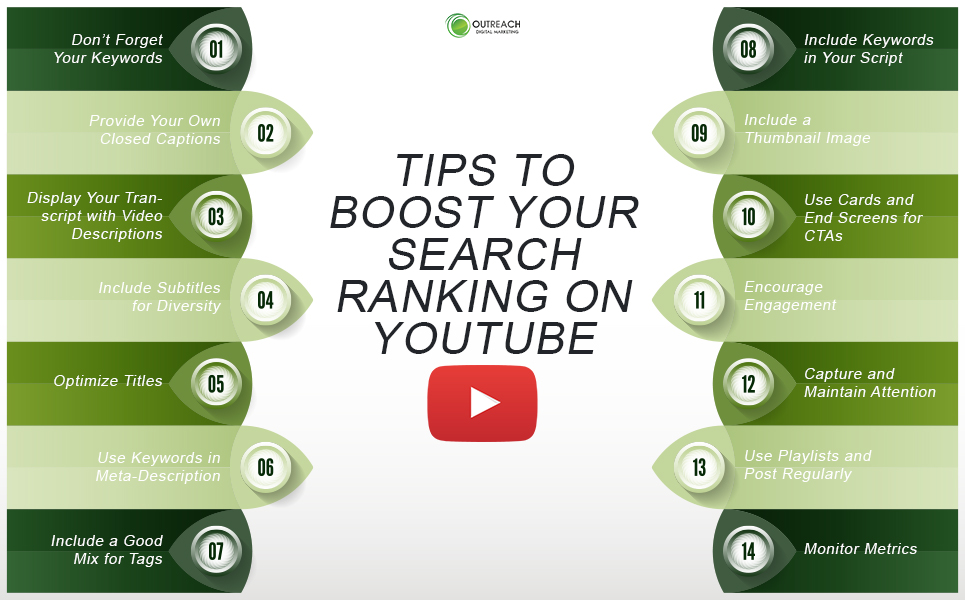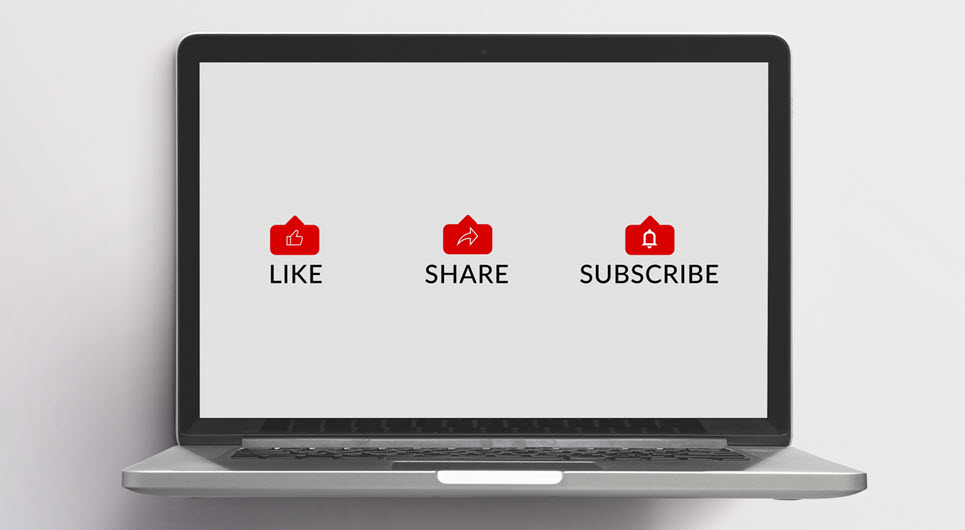Many small business owners focus on creating content such as blogging and social media. As a result, they miss out on the digital marketing opportunity video provides. In fact, YouTube happens to be the second-largest search engine in the world. As part of the Google family, YouTube videos continue to rise in rankings.
As a small business owner smart enough to hitch your little red wagon to this powerful tool, you might find despite your efforts, you just aren’t seeing the boost to the search ranking you had hoped. That’s because you forgot to develop a YouTube SEO strategy. Here we look at ways to improve your YouTube SEO strategy to finally see results.

Don’t Forget Your Keywords
Keywords and phrases are still important when posting YouTube videos. Although the words you speak aren’t read by search engines, your video titles, metadata, captions and transcripts are. Therefore, keywords and keyword phrases are still a major consideration when posting your videos. The right keywords include:
- A clear description of what your video contains
- The most likely words and phrases used to find the content your videos contain
YouTube’s Search Suggest tool provides suggestions based on the word or phrase most relevant to your industry. Your goal is to find high search volume keyword variations that stand out because they aren’t quite as competitive yet are still highly relevant. Long tail keyword phrases are also more specific, which helps provide more information about the content of your video. An example would be choosing “proper stucco wall painting technique tutorial” over “wall painting tutorial.”
Provide Your Own Closed Captions
Providing your own closed captions might seem like an immense hassle, but YouTube’s automatic captions are only 70% accurate. As a result, you could be showing potentially misleading or even gibberish captions that interfere with the quality of information you are sharing. This negatively impacts your SEO. In fact, auto-captions can mark your content as spam.
To provide your own closed captions, you need to use a “SubRip Subtitle” (SRT) file. This is a plain-text file that can be complicated to create. Although there are DIY options you can use to create an SRT, they are still time-consuming. A digital marketing service can create these files and include critical information such as start and end timestamps and accurate closed captions that can be crawled by search engines. With accurate captions, you improve search rankings, create a more engaging experience for viewers and make your videos accessible for the hearing impaired.
Display Your Transcript with Video Descriptions
YouTube provides a description field with 5,000 characters that can accommodate a 10-minute video transcript in most cases. If your transcript is too wordy, you can include a CTA that leads to the full version on a landing page. Your descriptions can be optimized with keywords and make it easier for people to decide if your content meets their needs. It’s like a shortcut to your information. It also provides the perfect base to create other content for social and blog posts. It’s a real digital marketing win-win.
Include Subtitles for Diversity
Even if your small business is local, there are people in your community who don’t speak English. Translating your script into the most common languages for your local target expands your reach and shows your commitment to diversity. Translated caption files are read by search engines which can be a nice boost to your SEO strategy. Just be sure your translations are provided by a professional translator who speaks, writes, and understands the language.
Optimize Titles
Keywords need to be used in any fields YouTube provides for text. This begins with your title. You have 100 characters for titles, keeping in mind only 70 appear in full. Write your titles to accommodate the keywords in those first 70 keywords and use heading optimized methods such as numbered lists, tips or hacks, how or why, or including words like guide or advice.
Use Keywords in Meta-Description
The meta-description field is also primed for keywords. You have a whopping 5,000 characters here, but only 120 show. Those first 120 characters should tell the audience what to expect, which in turn allows YouTube’s algorithms to understand your content. You also have the chance to include a compelling CTA with a link here, so consider where you want to send viewers next.
Include a Good Mix for Tags
Tags help searchers find your videos using keywords and phrases applied to your channel, videos, and playlists. You want to include a good mix of general and specific keywords directly from your title when creating your tags. In this case, you have 500 characters that you really don’t need. Don’t try to use them all, and instead, be concise with tags to see the best results. Include double quotes (“) to stress the words that are the most important in your long-tail phrases.
Include Keywords in Your Script
Whether you write a script or just go for it, you should say your keywords to ensure they appear in your transcript and captions. Make sure they sound completely natural as you speak without saying awkward phrases like “If you are looking for the best dentist Chicago” or “I understand the importance of the right window installer Chicago area.” This is far too “keywordy” and also makes you come across as hesitant and uncomfortable. Consider where keywords should flow in a conversational way early on in the video, and you should get a boost to your SEO.
Include a Thumbnail Image
If you don’t choose a thumbnail image, YouTube does it for you. The thumbnail is the little image that appears in the search results. You can upload a thumbnail that has a 16:9 aspect ratio to make the most of the space. Although facial close-ups of the presenter work well, if you can somehow select a shot in your video that shows something related to your keywords, you’ll see better results. This might be a close-up of hands working on a project, a finished project, or a before and after image.
Use Cards and End Screens for CTAs
YouTube provides cards and end screens that allow you to send messages while your video is playing. Cards appear in the top right of the video and are clickable. This makes them ideal for CTAs. You can direct people to relevant videos, pages on your website, or playlists you think they might enjoy. End screens provide a final opportunity to encourage viewers to act, whether it is to view the next video, subscribe to your channel or find more information about a product or service. Keep in mind YouTube wants people to stay on YouTube, not venture off to your website. So, find clever ways to get your message across while pleasing the YouTube powers that be.
Encourage Engagement
Videos with likes, shares and comments improve rankings. This tells Google that people are engaged with your video content and that it has encouraged a response. Ask for likes and shares at the end of your video and invite people to comment or ask questions. Be sure you respond to comments and answer questions promptly. This is also an excellent way to create new contacts and establish a rapport with potential customers.

Capture and Maintain Attention
Google really pays attention to how long people spend watching videos. If they see the average time spent watching your video is low, it means your content isn’t capturing the attention of viewers. However, they use a percentage in relation to the length of the video to measure watch time, which is a little complicated. For example, if you have a 10-minute video that gets watched 50% of the full length of the video, that video is ranked higher than a 3-minute video watched the whole way through. The trick is capturing attention right away and then maintaining attention to reach the desired percentage. Mentioning expected results for a weight loss program, profits from an investment strategy, or showing the finished project following instructional videos will help capture that desired watch time. You are viewed even more positively if someone not only watches your entire video but then proceeds to watch other videos on your playlist or channel.
Use Playlists and Post Regularly
Playlists create an easy way for viewers to binge-watch a series of relevant videos on your channel. Creating playlists of four to six related videos can create a better user experience and improve engagement. As well, taking a “series” approach to your video posts has a “tune in next week” feel that keeps people interested in what’s coming next. You can end your videos with a teaser about your next video while also creating a pattern that tells people when they can expect your next post. Both tactics improve watch times, the number of viewers and subscriptions to boost rankings.

Monitor Metrics
Tracking metrics through YouTube channel analytics helps you understand your performance. The most telling metrics include:
- Watch Time: How long people spend watching your videos.
- Impressions Click-Through Rate: How many people click your videos from their YouTube home page, trending videos and recommendations.
- Card Click-Through-Rate: How many people click your card CTAs when viewing your videos.
You can also monitor unique viewers, traffic sources, and how many subscribers you lose or gain. These metrics all provide insights to help you see how well your SEO strategy is working.
Want to boost video SEO? Get in touch with the team at Outreach Local Marketing.
